McPherson, double wishbone, torsion bars - what are they?!?
#1
PITA Admin
Administrator
Thread Starter
iTrader: (1)
Join Date: Dec 2008
Location: TN
Age: 52
Posts: 14,791
Received 1,446 Likes
on
1,201 Posts
Rep Power: 338 










McPherson, double wishbone, torsion bars - what are they?!?
This is a reply to another thread, but i think i will post it in separate to make easier to locate it in the search engine.
Warning! for this to be a good reference read, please DO NOT post questions here, just contributions!. No one wants to go through 100 pages of questions to find the info they want.
From what i know, Honda have used several geometrically different suspension configurations through the civic life.
Torsion bar (1st - 3rd generation)
The initial generations have used the torsion bar
from wikipedia on the 3rd gen - i am assuming the previous gen are torsion bars as well:
"This included independent front control arms with torsion bar springs and a semi-independent rear beam with coil springs. However, the body panels were largely different between models."
The bars will be housed inside the ""axles, and when under load, the bars will twist.
Below a beetle version:

no load in left, loaded in right


double wishbone (4th - 6th generation)
from wikipedia - changeover was done in the 4th gen
"For 1988, the Honda Civic was significantly redesigned. The suspension had a radical re-configuration with what Honda called "double-wishbone suspension" on all four corners, wheelbase was increased to 98.4 inches (250 cm), and the body was redesigned with a lower hood line and more glass, giving less drag.
Rear suspension however is more accurately described as multi-link trailing arm suspension since the upper control arm only has a single anchor and there is toe control used on the main trailing arm."
This rear suspension will be kept until the 8th gen, when they change for the doublewishbone again.
there will be two arms, the lower arm (darker green) and the upper one (brighter green). the length, picking point will provide a wider camber change across the suspension travel. Removing the shocks will not change the geometry, since the shocks are not part of the structure of the suspension.


However, they were replaced in behalf of a MacPherson type due to production costs.
MacPherson Struts (7th-8th generation, but 8th have modified version)
Changeover was on the 7th gen
the shock/damper is an integral part of the structure of the suspension - you remove the shock and the suspension geometry cannot be maintained.


the second one have a comprehensive description by color (thanks, Brian, saved me the time to go to the wikipedia page )
)
Red section: Steering knuckle or hub carrier
Blue section: Lower control arm or track control arm
Light blue section: Steering gear tie rod
Lower purple section: Radius rod
Upper purple Section: Coil spring
Yellow section: Tubular housing containing shock absorber or damper
The 8th gen had some changes in the rear suspension as well, making the car more neutral in cornering, from what i hear.
from honda.com:
http://www.honda.com/newsandviews/ar...=2005083039848
"a longer wheelbase
Control-Link MacPherson Strut Front Suspension with improved caster angle and toe-control dynamics
Multi-link compact double wishbone suspension with improved damper size and location
Wider track for sedan (+1.3 inches front/+2.5 inches rear)
Wider track for coupe (+1.1 inches front/+2.1 inches rear)"
The MacPherson strut front suspension incorporates new geometry with a high caster angle, and inversely wound springs for straight line stability, along with improved toe-control dynamics for sharp and responsive steering. To improve steering rigidity, and reduce friction, the steering gear box was mounted lower. Significant changes to steering angles, bushings, material rigidity, and spring and shock tuning result in amazingly linear suspension movement at the upper limit of vehicle dynamics and flatter cornering. When cornering, the inner wheel remains closer to perpendicular (relative to the ground plane) throughout a greater range of travel, which improves tire adhesion. To improve ride comfort, the compliance angle on the lower control arm was optimized to transmit less harshness. Further enhancements include less center offset with the wheel to minimize the potential for torque steer and shimmy (i.e. the tires' ability to transmit pavement irregularities into the suspension).

Honda engineers have also revisited the rear suspension to improve the Civic's handling precision and ride. The multi-link double wishbone rear suspension benefits from a new design that facilitates more rebound stroke and improved positioning of the damper. The improved rebound stroke allows the vehicle to soak up bumps and harsh road surfaces with quietness and ease, while also enhancing overall stability. The damper is mounted closer to the wheels for a more favorable 1.1:1 lever ratio between suspension movement and the distance that the damper actually travels (the previous ratio was 1.7:1). The more direct relationship means the dampers are able to provide better damping and control throughout the full range of suspension travel. These enhancements combined with sport-oriented spring and damper settings greatly increase the overall sporty feel of the vehicle and increase the feeling of coordination between the front and rear suspensions (a surprisingly uncommon trait in many vehicles).

As with every vehicle that utilizes a front strut suspension design, the strut bears the load of the weight of the vehicle. Drive forces during the suspension's compression stage can sometimes influence steering precision because as the springs compress, they exert torsional force in the opposite direction on the steering mechanism and sometimes make the car pull to the side. To neutralize this effect, Honda engineers applied inversely wound (wound in the opposite direction) coil springs to the front struts. Because the two front springs compress in opposite directions, the torsional force they produce cancels each other out, minimizing their effect on steering.
Damper construction is a progressive valve design that significantly contributes to a smooth ride and precise handling characteristics. These gas-pressure dampers use a stacked disc-valve arrangement that yields easily and progressively to high-velocity damper piston movement, such as those created by bumps and road impacts; however, the same velocity-sensitive valves present more resistance to the small, low-velocity movement associated with body transient motion at high speed.
All models (except for the DX) feature front and rear stabilizer bars to reduce body roll during cornering. The diameter of the front stabilizer bar on non-Si models measures 24.2 mm (tubular with a wall thickness of 3.0 mm). Solid rear stabilizer bars on non-Si models measure 10 mm.

This thread will be updated as i check for more information, so bear with me
Semantically and technically, if you remove the shocks/dampers in a doublewishbone suspension, you do not need to align it because the shock/damper is not actually a part of what holds the suspension together
No camber gain: Because the top of the vertical strut is mounted rigidly to the body structure, MacPherson struts do not provide camber gain -- the wheels lose camber as the body leans. You can compensate to some degree by designing the suspension with a few degrees of static negative camber (that is, aligning the wheels so that the upper halves are tilted slightly inward when the car is level), but too much negative camber causes uneven tire wear. The only way to prevent camber loss is to use stiffer springs and/or anti-roll bars to reduce body lean, which results in a stiffer ride. It's possible to make a MacPherson strut car handle very well, as Porsche, Volkswagen, and BMW have repeatedly demonstrated, but it compromises ride quality more than would be the case with a double-wishbone suspension.
Sooo, by just dropping the car, the rears should look like /\, but not the fronts.
when the camber goes neg, the geometry makes toe go out, hence the twitch description
Warning! for this to be a good reference read, please DO NOT post questions here, just contributions!. No one wants to go through 100 pages of questions to find the info they want.
From what i know, Honda have used several geometrically different suspension configurations through the civic life.
Torsion bar (1st - 3rd generation)
The initial generations have used the torsion bar
from wikipedia on the 3rd gen - i am assuming the previous gen are torsion bars as well:
"This included independent front control arms with torsion bar springs and a semi-independent rear beam with coil springs. However, the body panels were largely different between models."
The bars will be housed inside the ""axles, and when under load, the bars will twist.
Below a beetle version:

no load in left, loaded in right


double wishbone (4th - 6th generation)
from wikipedia - changeover was done in the 4th gen
"For 1988, the Honda Civic was significantly redesigned. The suspension had a radical re-configuration with what Honda called "double-wishbone suspension" on all four corners, wheelbase was increased to 98.4 inches (250 cm), and the body was redesigned with a lower hood line and more glass, giving less drag.
Rear suspension however is more accurately described as multi-link trailing arm suspension since the upper control arm only has a single anchor and there is toe control used on the main trailing arm."
This rear suspension will be kept until the 8th gen, when they change for the doublewishbone again.
there will be two arms, the lower arm (darker green) and the upper one (brighter green). the length, picking point will provide a wider camber change across the suspension travel. Removing the shocks will not change the geometry, since the shocks are not part of the structure of the suspension.


However, they were replaced in behalf of a MacPherson type due to production costs.
MacPherson Struts (7th-8th generation, but 8th have modified version)
Changeover was on the 7th gen
the shock/damper is an integral part of the structure of the suspension - you remove the shock and the suspension geometry cannot be maintained.


the second one have a comprehensive description by color (thanks, Brian, saved me the time to go to the wikipedia page
 )
)Red section: Steering knuckle or hub carrier
Blue section: Lower control arm or track control arm
Light blue section: Steering gear tie rod
Lower purple section: Radius rod
Upper purple Section: Coil spring
Yellow section: Tubular housing containing shock absorber or damper
The 8th gen had some changes in the rear suspension as well, making the car more neutral in cornering, from what i hear.
from honda.com:
http://www.honda.com/newsandviews/ar...=2005083039848
"a longer wheelbase
Control-Link MacPherson Strut Front Suspension with improved caster angle and toe-control dynamics
Multi-link compact double wishbone suspension with improved damper size and location
Wider track for sedan (+1.3 inches front/+2.5 inches rear)
Wider track for coupe (+1.1 inches front/+2.1 inches rear)"
The MacPherson strut front suspension incorporates new geometry with a high caster angle, and inversely wound springs for straight line stability, along with improved toe-control dynamics for sharp and responsive steering. To improve steering rigidity, and reduce friction, the steering gear box was mounted lower. Significant changes to steering angles, bushings, material rigidity, and spring and shock tuning result in amazingly linear suspension movement at the upper limit of vehicle dynamics and flatter cornering. When cornering, the inner wheel remains closer to perpendicular (relative to the ground plane) throughout a greater range of travel, which improves tire adhesion. To improve ride comfort, the compliance angle on the lower control arm was optimized to transmit less harshness. Further enhancements include less center offset with the wheel to minimize the potential for torque steer and shimmy (i.e. the tires' ability to transmit pavement irregularities into the suspension).

Honda engineers have also revisited the rear suspension to improve the Civic's handling precision and ride. The multi-link double wishbone rear suspension benefits from a new design that facilitates more rebound stroke and improved positioning of the damper. The improved rebound stroke allows the vehicle to soak up bumps and harsh road surfaces with quietness and ease, while also enhancing overall stability. The damper is mounted closer to the wheels for a more favorable 1.1:1 lever ratio between suspension movement and the distance that the damper actually travels (the previous ratio was 1.7:1). The more direct relationship means the dampers are able to provide better damping and control throughout the full range of suspension travel. These enhancements combined with sport-oriented spring and damper settings greatly increase the overall sporty feel of the vehicle and increase the feeling of coordination between the front and rear suspensions (a surprisingly uncommon trait in many vehicles).

As with every vehicle that utilizes a front strut suspension design, the strut bears the load of the weight of the vehicle. Drive forces during the suspension's compression stage can sometimes influence steering precision because as the springs compress, they exert torsional force in the opposite direction on the steering mechanism and sometimes make the car pull to the side. To neutralize this effect, Honda engineers applied inversely wound (wound in the opposite direction) coil springs to the front struts. Because the two front springs compress in opposite directions, the torsional force they produce cancels each other out, minimizing their effect on steering.
Damper construction is a progressive valve design that significantly contributes to a smooth ride and precise handling characteristics. These gas-pressure dampers use a stacked disc-valve arrangement that yields easily and progressively to high-velocity damper piston movement, such as those created by bumps and road impacts; however, the same velocity-sensitive valves present more resistance to the small, low-velocity movement associated with body transient motion at high speed.
All models (except for the DX) feature front and rear stabilizer bars to reduce body roll during cornering. The diameter of the front stabilizer bar on non-Si models measures 24.2 mm (tubular with a wall thickness of 3.0 mm). Solid rear stabilizer bars on non-Si models measure 10 mm.

This thread will be updated as i check for more information, so bear with me

Semantically and technically, if you remove the shocks/dampers in a doublewishbone suspension, you do not need to align it because the shock/damper is not actually a part of what holds the suspension together
our front suspension is Macpherson type - the camber changes across the suspension travel is close to negligible - dropping the car is not supposed to cause any visible changes - when you lift, the suspension at full droop will have a somewhat visible change to positive, but that's a lot of travel.
Also, the front camber kit for our cars is just an eccentric bolt. Rears are multi-link type designed to gain a lot of negative camber (to understeer the car in the limit - good for average driver).
Also, the front camber kit for our cars is just an eccentric bolt. Rears are multi-link type designed to gain a lot of negative camber (to understeer the car in the limit - good for average driver).
Sooo, by just dropping the car, the rears should look like /\, but not the fronts.
when the camber goes neg, the geometry makes toe go out, hence the twitch description
Last edited by sdaidoji; 04-17-2011 at 05:55 PM.
#2
PITA Admin
Administrator
Thread Starter
iTrader: (1)
Join Date: Dec 2008
Location: TN
Age: 52
Posts: 14,791
Received 1,446 Likes
on
1,201 Posts
Rep Power: 338 










Re: McPherson, double wishbone, torsion bars - what are they?!?
This is a transcription of the link:
the complete text is located here:
http://ateupwithmotor.com/technology...t-history.html
The MacPherson Strut
Written by Aaron Severson
Saturday, 31 January 2009 00:00
It's one of the most common suspension designs used on modern cars, found on everything from the lowliest Proton Savvy to the fearsome Porsche 911 Turbo. It's also frequently misunderstood and often misspelled. This week, we will try to set the record straight about the origins and workings of the MacPherson strut suspension system.
BASICS OF INDEPENDENT SUSPENSION DESIGN
To understand how the MacPherson strut works, we must first consider why you would want independent suspension in the first place. Beam axles are simple, cheap, and sturdy, which is why they serve perfectly well for horse-drawn carriages and heavy-duty vehicles. However, an independent suspension has several major advantages over a beam axle. First (and most obviously), it allows each wheel to move separately, so that a bump that affects one wheel doesn't necessarily affect the other. Second, it avoids the uncontrolled oscillations created by a beam axle, which would otherwise cause wheel tramp and shimmy, hurting both handling and directional stability. Third, independent suspension reduces the vehicle's unsprung weight.
(A car's sprung weight is the mass supported by the suspension: the body, engine, passengers, and cargo. The car's unsprung weight is the mass of the suspension components, wheels, tires, and anything that moves with them, such as the brakes, if they are mounted in the wheels, or the beam connecting the wheels of a beam-axle suspension. Every time the car hits a bump, its suspension transmits the force to the body; the greater the unsprung weight, the more severe the shock. High unsprung weight also increases the inertia of the suspension components, making it harder to change their direction, or to quell their motion once they've started moving.)
As a result, a car with independent suspension -- particularly for the front wheels -- tends to have better handling and ride quality than one with a beam axle, which is why IFS became standard on most cars by the late forties. (Of course, as with all things, the theory and the practice are often different things. Ford's first independent front suspension, introduced in 1949, had very poor geometry, and its early IFS cars handled notably worse than their beam-axle predecessors.)
Outside of a brief flirtation with Dubonnet cylinders, the most common form of independent front suspension on American cars of the forties (and for about thirty years thereafter) was the unequal-length control-arm or double-wishbone layout.

The double-wishbone front suspension of a much-modified 1971 Chevrolet Chevelle. This appears to be an aftermarket installation, but it illustrates the basic components: wishbone-shaped upper and lower control arms supporting the wheel spindle, with a coil spring surrounding the shock absorber, mounted on the lower arm. Not evident in this photo is a front anti-roll bar. On Chevy front suspensions of this vintage, the anti-roll bar usually connects to the lower control arm, approximately where the empty hole is located, outboard of the spring.
As you can see from the above illustration, a double-wishbone suspension connects the wheel spindle (red) to the frame with two transverse control arms, each shaped like a wishbone or a capital A. The upper control arm (green) is shorter than the lower arm (orange) by 20-50%. A tubular shock absorber (purple) is mounted between the arms. The actual suspension is usually by coil springs (yellow), which are sometimes mounted over the shock absorbers ("coil-over") to save space; some cars mount the spring on the inboard side of the lower arm or on top of the upper arm, while others substitute torsion bars or semi-elliptical leaf springs. On many cars, there is also an anti-roll bar (blue), a torsion bar spring that connects the lower control arm to its counterpart on the other side of the car.
A properly designed double-wishbone suspension offers a number of benefits, compared to either a beam axle or other types of independent suspension, like swing arms or trailing arms:
Low unsprung weight: The control arms themselves are relatively light, and only a portion of their mass is actually part of the unsprung weight, which keeps the total unsprung mass quite low.
Strength: The triangular wishbone shape of the control arms makes them stiffer without making them heavier, helping them resist bending and distortion -- important to avoid shimmy and wheel tramp.
Long swing-arm length: Swing-arm length is the radius of the arc through which the wheel moves as it goes up and down on the springs. If this radius is relatively short, as on a swing-arm or swing-axle suspension, the wheel traces a long arc between the extremes of its travel. This often results in major changes in wheel alignment, which produces erratic handling. Making the effective swing-arm length as long as possible keeps the geometry of the wheel closer to constant, giving more predictable handling.
Camber gain: Tires have the best traction when they are vertical -- that is, when their camber angle is zero. With a beam axle or trailing arms, as the body leans toward the outside of the turn, the top of the outside wheel tilts outward, reducing its grip on the pavement; this is called camber loss, and it reduces the car's maximum cornering power. With a double-wishbone suspension, the longer lower control arm causes the lower half of the wheel to tilt faster than the upper half, which keeps the wheel's camber closer to zero, even as the body leans; this is called camber gain, and it greatly improves handling ability.
A double-wishbone suspension has three major drawbacks:
Cost: An unequal-length control arm suspension is fairly complicated (particularly compared to a beam axle), which costs more to build and install.
Width: The control arms need to be relatively long to provide good suspension geometry, which takes up more space in the body.
Weight: Along with their bulk, the wishbones are relatively heavy, which adds to the unsprung mass. This can be alleviated by using lightweight materials, such as aluminum or magnesium, but that in turn adds to the cost.
THE MACPHERSON STRUT
Earle MacPherson confronted both of these limitations when designing the Cadet in the mid-forties. The Cadet's track width was only about 48 inches (122 cm) -- fully a foot (30 cm) narrower than the track width of a contemporary full-size Chevrolet -- which didn't leave a lot of space for suspension components. Furthermore, the ambitious price target meant that the cost had to be reduced as much as possible. Beam axles would have been easier, but they would not have provided acceptable ride or handling, particularly considering the Cadet's low sprung mass.
MacPherson's strategy was essentially to simplify the unequal-length control arm layout. The Cadet's suspension retained the lower control arm, which was actually formed by a relatively narrow transverse arm and a skinny, diagonal radius rod. Instead of an upper control arm, however, the wheel spindle was mounted on a vertical strut, mounted rigidly to the body. The strut incorporated a tubular shock absorber, and it served both as the upper control arm and as the axis around which the front wheels were steered. The coil spring was mounted over the upper part of the strut, near where it attached to the body; this saved space, and allowed the lower control arm to be thinner, since it didn't have to handle the loads generated by the springs.
The refined version of this design, first used in the Vedette and found on many modern cars, dispenses with the radius rods. Instead, it uses a torsion bar spring, connected to the outer end of each lower control arm. The torsion bar acts as an anti-roll bar, and it also triangulates the control arms, acting as the front half of each lower "wishbone."

A badly damaged late-nineties Saturn SL1 shows off its MacPherson strut front suspension. The upper control arm of the SLA suspension is omitted entirely, its locating function provided by the shock absorber/strut, which is mounted directly to the wheel spindle. The lower control arm is narrower and lighter, but it gains strength through its triangulation with the anti-roll bar -- note how the anti-roll bar and control arm form a wishbone shape. Also note the location of the engine driveshaft (identifiable by the rubber CV boots on each end) -- with a MacPherson strut, there are no suspension components to block the driveshaft.
By eliminating several components and making others do double duty, the MacPherson strut design is both cheaper and lighter than a double-wishbone suspension. It's also narrower, which is helpful in smaller cars with transverse engines. Although MacPherson didn't have front-wheel drive in mind when he designed this suspension, it has an additional advantage for FWD cars in that there are no suspension components to interfere with the driveshafts, which is not the case for many double-wishbone designs.
Most MacPherson strut suspensions use coil springs mounted high on the struts, like MacPherson's original designs, but that isn't universally true. Porsche has frequently used MacPherson strut suspensions with torsion bars, rather than coil springs, while both Ford's Fox platform and GM's 1982-1992 Camaro and Firebird used "modified MacPherson struts" with the coil springs mounted on the lower control arms, rather than on the shock towers. By the same token, there are many suspensions with coil-over shocks that are not MacPherson struts. What defines a strut suspension is not the location or integration of the spring, but the use of the shock tower as the upper control arm.
MacPherson struts offer many of the benefits of a double-wishbone suspension, including strength, long swing-arm length, and low unsprung weight, but without the cost and space penalties. However, they also have several significant drawbacks, including:
Unsuitability for body-on-frame vehicles: The vertical strut must be firmly attached to the body, which in turn must be strong enough to absorb the loads created by the suspension. That generally requires a unitized or semi-unitized body; with a body-on-frame car, the body is generally not rigid enough to handle those loads. (This is why MacPherson struts were not common on domestic cars until the 1980s.)
Excessive height: Although a MacPherson strut suspension isn't very wide, it is taller than a double-wishbone layout, which means it doesn't fit well in cars with a low hood line. Some MacPherson-strut cars (like Mitsubishi's 1990-2001 GTO/3000GT and the related Dodge Stealth) have noticeable bulges in the hood or front fenders to provide clearance for the shock towers.
High replacement cost: Because the vertical struts are also the shock absorbers -- and sometimes incorporate the springs, as well -- replacing the shocks on a car with MacPherson strut suspension is usually more expensive than changing the shocks on a comparable vehicle with double-wishbone suspension.
No camber gain: Because the top of the vertical strut is mounted rigidly to the body structure, MacPherson struts do not provide camber gain -- the wheels lose camber as the body leans. You can compensate to some degree by designing the suspension with a few degrees of static negative camber (that is, aligning the wheels so that the upper halves are tilted slightly inward when the car is level), but too much negative camber causes uneven tire wear. The only way to prevent camber loss is to use stiffer springs and/or anti-roll bars to reduce body lean, which results in a stiffer ride. It's possible to make a MacPherson strut car handle very well, as Porsche, Volkswagen, and BMW have repeatedly demonstrated, but it compromises ride quality more than would be the case with a double-wishbone suspension.
Despite these drawbacks, the MacPherson strut suspension remains very popular for both economy cars, and for any vehicle where space is at a premium. Even automakers like Honda, which has traditionally preferred double-wishbone suspensions, have gone to MacPherson struts for their smaller cars. That's not a bad legacy for an engineer -- even if nobody can spell his name right.
# # #
the complete text is located here:
http://ateupwithmotor.com/technology...t-history.html
The MacPherson Strut
Written by Aaron Severson
Saturday, 31 January 2009 00:00
It's one of the most common suspension designs used on modern cars, found on everything from the lowliest Proton Savvy to the fearsome Porsche 911 Turbo. It's also frequently misunderstood and often misspelled. This week, we will try to set the record straight about the origins and workings of the MacPherson strut suspension system.
BASICS OF INDEPENDENT SUSPENSION DESIGN
To understand how the MacPherson strut works, we must first consider why you would want independent suspension in the first place. Beam axles are simple, cheap, and sturdy, which is why they serve perfectly well for horse-drawn carriages and heavy-duty vehicles. However, an independent suspension has several major advantages over a beam axle. First (and most obviously), it allows each wheel to move separately, so that a bump that affects one wheel doesn't necessarily affect the other. Second, it avoids the uncontrolled oscillations created by a beam axle, which would otherwise cause wheel tramp and shimmy, hurting both handling and directional stability. Third, independent suspension reduces the vehicle's unsprung weight.
(A car's sprung weight is the mass supported by the suspension: the body, engine, passengers, and cargo. The car's unsprung weight is the mass of the suspension components, wheels, tires, and anything that moves with them, such as the brakes, if they are mounted in the wheels, or the beam connecting the wheels of a beam-axle suspension. Every time the car hits a bump, its suspension transmits the force to the body; the greater the unsprung weight, the more severe the shock. High unsprung weight also increases the inertia of the suspension components, making it harder to change their direction, or to quell their motion once they've started moving.)
As a result, a car with independent suspension -- particularly for the front wheels -- tends to have better handling and ride quality than one with a beam axle, which is why IFS became standard on most cars by the late forties. (Of course, as with all things, the theory and the practice are often different things. Ford's first independent front suspension, introduced in 1949, had very poor geometry, and its early IFS cars handled notably worse than their beam-axle predecessors.)
Outside of a brief flirtation with Dubonnet cylinders, the most common form of independent front suspension on American cars of the forties (and for about thirty years thereafter) was the unequal-length control-arm or double-wishbone layout.

The double-wishbone front suspension of a much-modified 1971 Chevrolet Chevelle. This appears to be an aftermarket installation, but it illustrates the basic components: wishbone-shaped upper and lower control arms supporting the wheel spindle, with a coil spring surrounding the shock absorber, mounted on the lower arm. Not evident in this photo is a front anti-roll bar. On Chevy front suspensions of this vintage, the anti-roll bar usually connects to the lower control arm, approximately where the empty hole is located, outboard of the spring.
As you can see from the above illustration, a double-wishbone suspension connects the wheel spindle (red) to the frame with two transverse control arms, each shaped like a wishbone or a capital A. The upper control arm (green) is shorter than the lower arm (orange) by 20-50%. A tubular shock absorber (purple) is mounted between the arms. The actual suspension is usually by coil springs (yellow), which are sometimes mounted over the shock absorbers ("coil-over") to save space; some cars mount the spring on the inboard side of the lower arm or on top of the upper arm, while others substitute torsion bars or semi-elliptical leaf springs. On many cars, there is also an anti-roll bar (blue), a torsion bar spring that connects the lower control arm to its counterpart on the other side of the car.
A properly designed double-wishbone suspension offers a number of benefits, compared to either a beam axle or other types of independent suspension, like swing arms or trailing arms:
Low unsprung weight: The control arms themselves are relatively light, and only a portion of their mass is actually part of the unsprung weight, which keeps the total unsprung mass quite low.
Strength: The triangular wishbone shape of the control arms makes them stiffer without making them heavier, helping them resist bending and distortion -- important to avoid shimmy and wheel tramp.
Long swing-arm length: Swing-arm length is the radius of the arc through which the wheel moves as it goes up and down on the springs. If this radius is relatively short, as on a swing-arm or swing-axle suspension, the wheel traces a long arc between the extremes of its travel. This often results in major changes in wheel alignment, which produces erratic handling. Making the effective swing-arm length as long as possible keeps the geometry of the wheel closer to constant, giving more predictable handling.
Camber gain: Tires have the best traction when they are vertical -- that is, when their camber angle is zero. With a beam axle or trailing arms, as the body leans toward the outside of the turn, the top of the outside wheel tilts outward, reducing its grip on the pavement; this is called camber loss, and it reduces the car's maximum cornering power. With a double-wishbone suspension, the longer lower control arm causes the lower half of the wheel to tilt faster than the upper half, which keeps the wheel's camber closer to zero, even as the body leans; this is called camber gain, and it greatly improves handling ability.
A double-wishbone suspension has three major drawbacks:
Cost: An unequal-length control arm suspension is fairly complicated (particularly compared to a beam axle), which costs more to build and install.
Width: The control arms need to be relatively long to provide good suspension geometry, which takes up more space in the body.
Weight: Along with their bulk, the wishbones are relatively heavy, which adds to the unsprung mass. This can be alleviated by using lightweight materials, such as aluminum or magnesium, but that in turn adds to the cost.
THE MACPHERSON STRUT
Earle MacPherson confronted both of these limitations when designing the Cadet in the mid-forties. The Cadet's track width was only about 48 inches (122 cm) -- fully a foot (30 cm) narrower than the track width of a contemporary full-size Chevrolet -- which didn't leave a lot of space for suspension components. Furthermore, the ambitious price target meant that the cost had to be reduced as much as possible. Beam axles would have been easier, but they would not have provided acceptable ride or handling, particularly considering the Cadet's low sprung mass.
MacPherson's strategy was essentially to simplify the unequal-length control arm layout. The Cadet's suspension retained the lower control arm, which was actually formed by a relatively narrow transverse arm and a skinny, diagonal radius rod. Instead of an upper control arm, however, the wheel spindle was mounted on a vertical strut, mounted rigidly to the body. The strut incorporated a tubular shock absorber, and it served both as the upper control arm and as the axis around which the front wheels were steered. The coil spring was mounted over the upper part of the strut, near where it attached to the body; this saved space, and allowed the lower control arm to be thinner, since it didn't have to handle the loads generated by the springs.
The refined version of this design, first used in the Vedette and found on many modern cars, dispenses with the radius rods. Instead, it uses a torsion bar spring, connected to the outer end of each lower control arm. The torsion bar acts as an anti-roll bar, and it also triangulates the control arms, acting as the front half of each lower "wishbone."

A badly damaged late-nineties Saturn SL1 shows off its MacPherson strut front suspension. The upper control arm of the SLA suspension is omitted entirely, its locating function provided by the shock absorber/strut, which is mounted directly to the wheel spindle. The lower control arm is narrower and lighter, but it gains strength through its triangulation with the anti-roll bar -- note how the anti-roll bar and control arm form a wishbone shape. Also note the location of the engine driveshaft (identifiable by the rubber CV boots on each end) -- with a MacPherson strut, there are no suspension components to block the driveshaft.
By eliminating several components and making others do double duty, the MacPherson strut design is both cheaper and lighter than a double-wishbone suspension. It's also narrower, which is helpful in smaller cars with transverse engines. Although MacPherson didn't have front-wheel drive in mind when he designed this suspension, it has an additional advantage for FWD cars in that there are no suspension components to interfere with the driveshafts, which is not the case for many double-wishbone designs.
Most MacPherson strut suspensions use coil springs mounted high on the struts, like MacPherson's original designs, but that isn't universally true. Porsche has frequently used MacPherson strut suspensions with torsion bars, rather than coil springs, while both Ford's Fox platform and GM's 1982-1992 Camaro and Firebird used "modified MacPherson struts" with the coil springs mounted on the lower control arms, rather than on the shock towers. By the same token, there are many suspensions with coil-over shocks that are not MacPherson struts. What defines a strut suspension is not the location or integration of the spring, but the use of the shock tower as the upper control arm.
MacPherson struts offer many of the benefits of a double-wishbone suspension, including strength, long swing-arm length, and low unsprung weight, but without the cost and space penalties. However, they also have several significant drawbacks, including:
Unsuitability for body-on-frame vehicles: The vertical strut must be firmly attached to the body, which in turn must be strong enough to absorb the loads created by the suspension. That generally requires a unitized or semi-unitized body; with a body-on-frame car, the body is generally not rigid enough to handle those loads. (This is why MacPherson struts were not common on domestic cars until the 1980s.)
Excessive height: Although a MacPherson strut suspension isn't very wide, it is taller than a double-wishbone layout, which means it doesn't fit well in cars with a low hood line. Some MacPherson-strut cars (like Mitsubishi's 1990-2001 GTO/3000GT and the related Dodge Stealth) have noticeable bulges in the hood or front fenders to provide clearance for the shock towers.
High replacement cost: Because the vertical struts are also the shock absorbers -- and sometimes incorporate the springs, as well -- replacing the shocks on a car with MacPherson strut suspension is usually more expensive than changing the shocks on a comparable vehicle with double-wishbone suspension.
No camber gain: Because the top of the vertical strut is mounted rigidly to the body structure, MacPherson struts do not provide camber gain -- the wheels lose camber as the body leans. You can compensate to some degree by designing the suspension with a few degrees of static negative camber (that is, aligning the wheels so that the upper halves are tilted slightly inward when the car is level), but too much negative camber causes uneven tire wear. The only way to prevent camber loss is to use stiffer springs and/or anti-roll bars to reduce body lean, which results in a stiffer ride. It's possible to make a MacPherson strut car handle very well, as Porsche, Volkswagen, and BMW have repeatedly demonstrated, but it compromises ride quality more than would be the case with a double-wishbone suspension.
Despite these drawbacks, the MacPherson strut suspension remains very popular for both economy cars, and for any vehicle where space is at a premium. Even automakers like Honda, which has traditionally preferred double-wishbone suspensions, have gone to MacPherson struts for their smaller cars. That's not a bad legacy for an engineer -- even if nobody can spell his name right.
# # #
Last edited by sdaidoji; 04-17-2011 at 05:52 PM. Reason: Eliminated some of the history to ease the reading. full text can be found in the link
#3
PITA Admin
Administrator
Thread Starter
iTrader: (1)
Join Date: Dec 2008
Location: TN
Age: 52
Posts: 14,791
Received 1,446 Likes
on
1,201 Posts
Rep Power: 338 










Re: McPherson, double wishbone, torsion bars - what are they?!?
Some more data on them.
Torsion bars:
http://en.wikipedia.org/wiki/Torsion_bar
Double wishbone
http://en.wikipedia.org/wiki/Double_wishbone
McPherson
http://en.wikipedia.org/wiki/McPherson_suspension
Torsion bars:
http://en.wikipedia.org/wiki/Torsion_bar
Double wishbone
http://en.wikipedia.org/wiki/Double_wishbone
McPherson
http://en.wikipedia.org/wiki/McPherson_suspension
Last edited by sdaidoji; 04-17-2011 at 05:53 PM.
#4
PITA Admin
Administrator
Thread Starter
iTrader: (1)
Join Date: Dec 2008
Location: TN
Age: 52
Posts: 14,791
Received 1,446 Likes
on
1,201 Posts
Rep Power: 338 










Re: McPherson, double wishbone, torsion bars - what are they?!?
6th gen (Thanks for posting it here, MB )
)
Front:
Differing from other double wishbone types, the upper arm is considerably high in the car, and mounted in the chassis, not a sub-frame. this is more prone to chassis flex than i initially thought of the suspension...
compare with the most normal type, monted in the sub-frame...

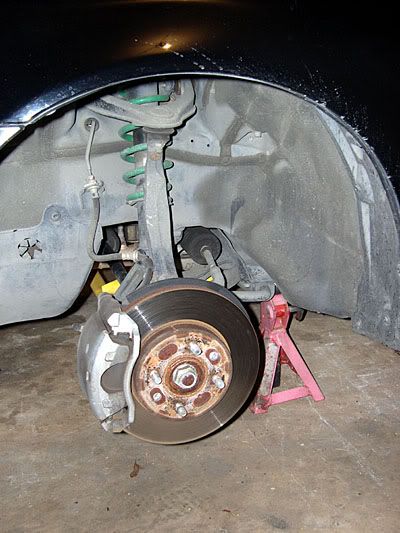
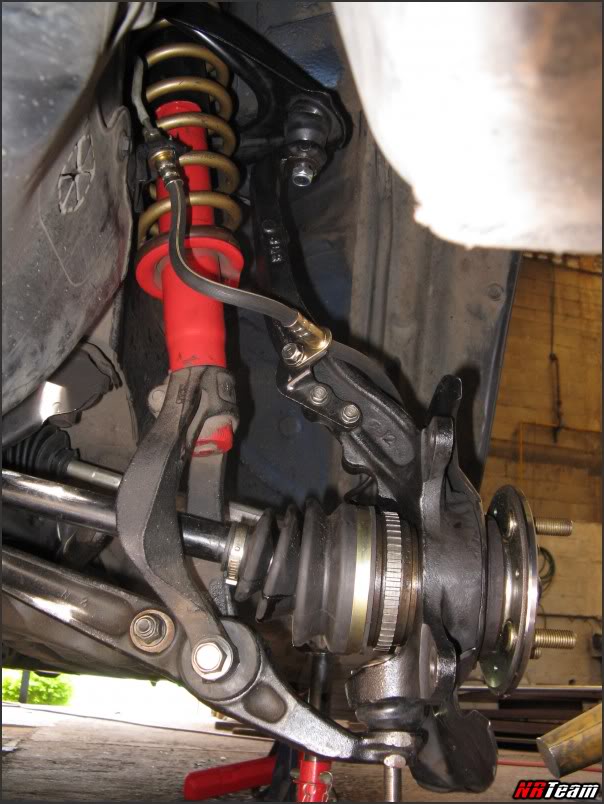
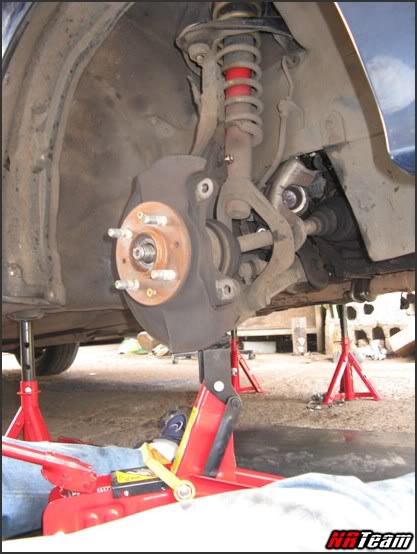
upper control arm
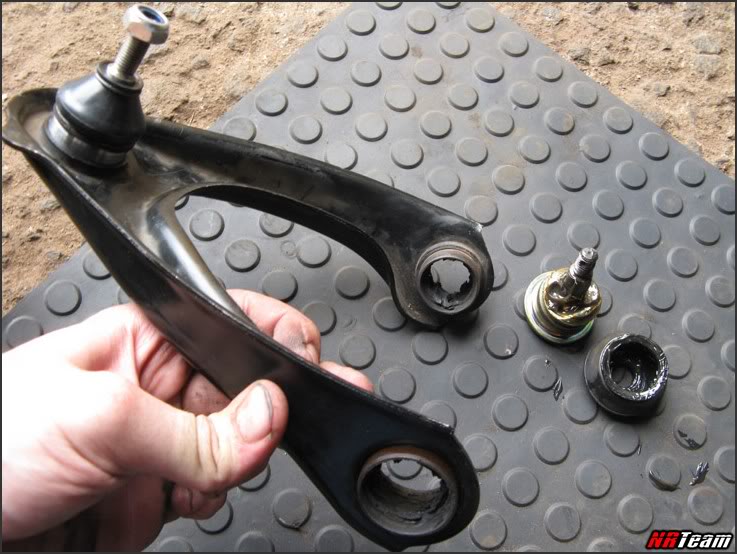
LCA
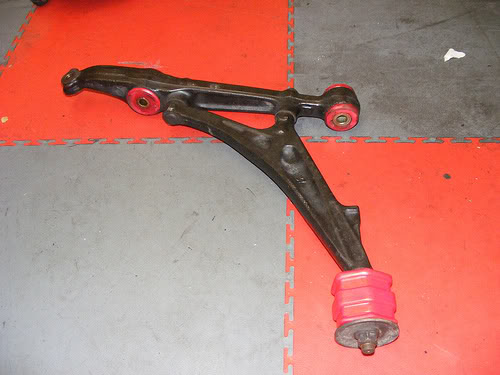
Rear:
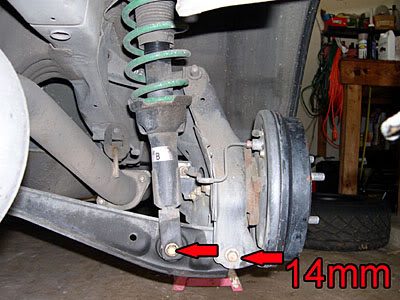
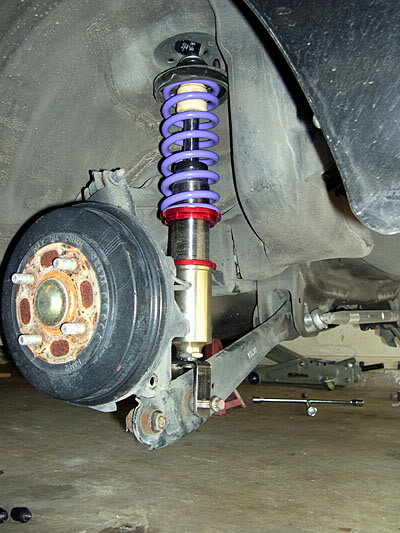
Now note below that there is no "knuckle type - the arm itself holds the hub/drum.
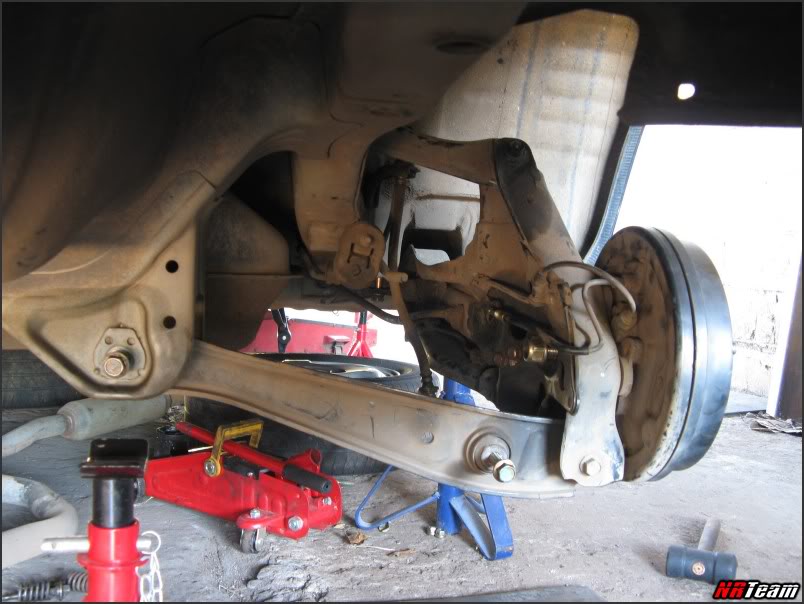
Trailing arm removed
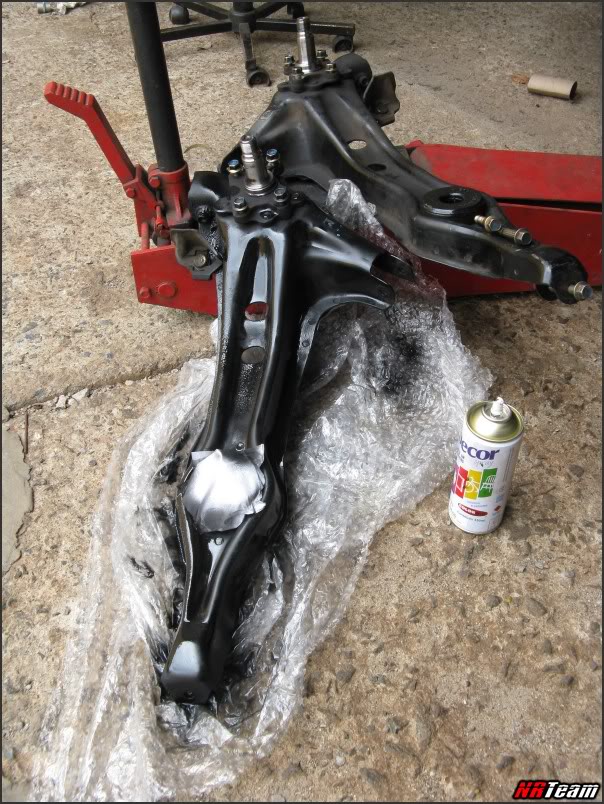
7th gen
Fronts: (Thanks, Tbohar)
A view of the strut with kuckle/disk in place
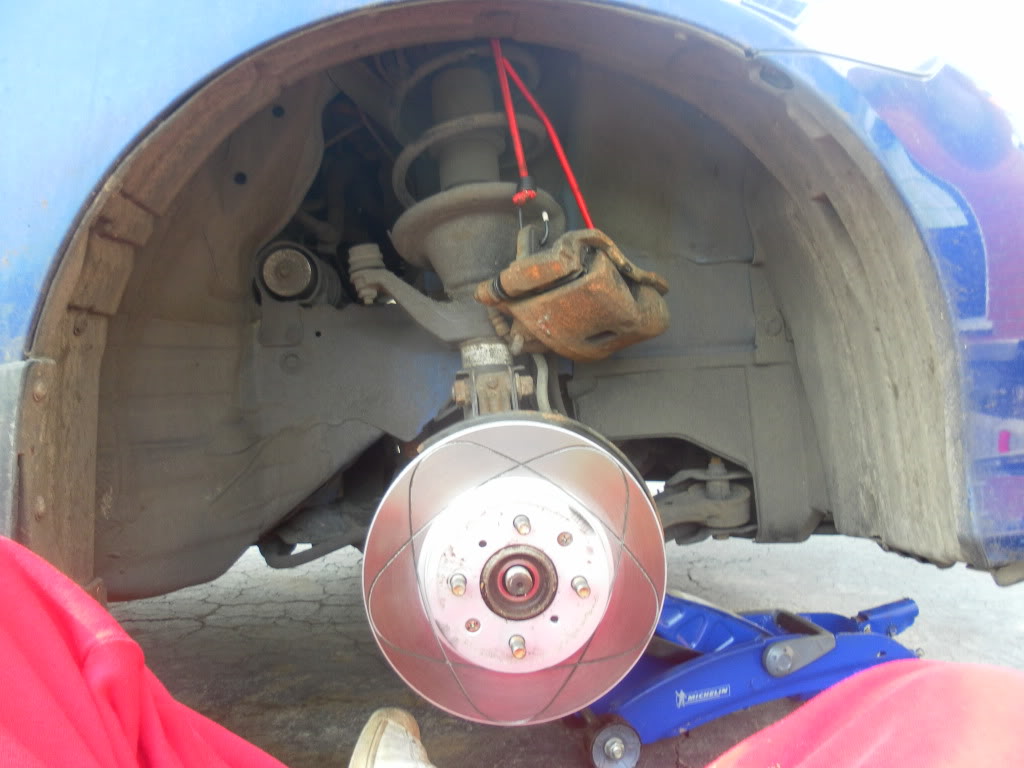
Strut-to-knuckle "camber" bolts:
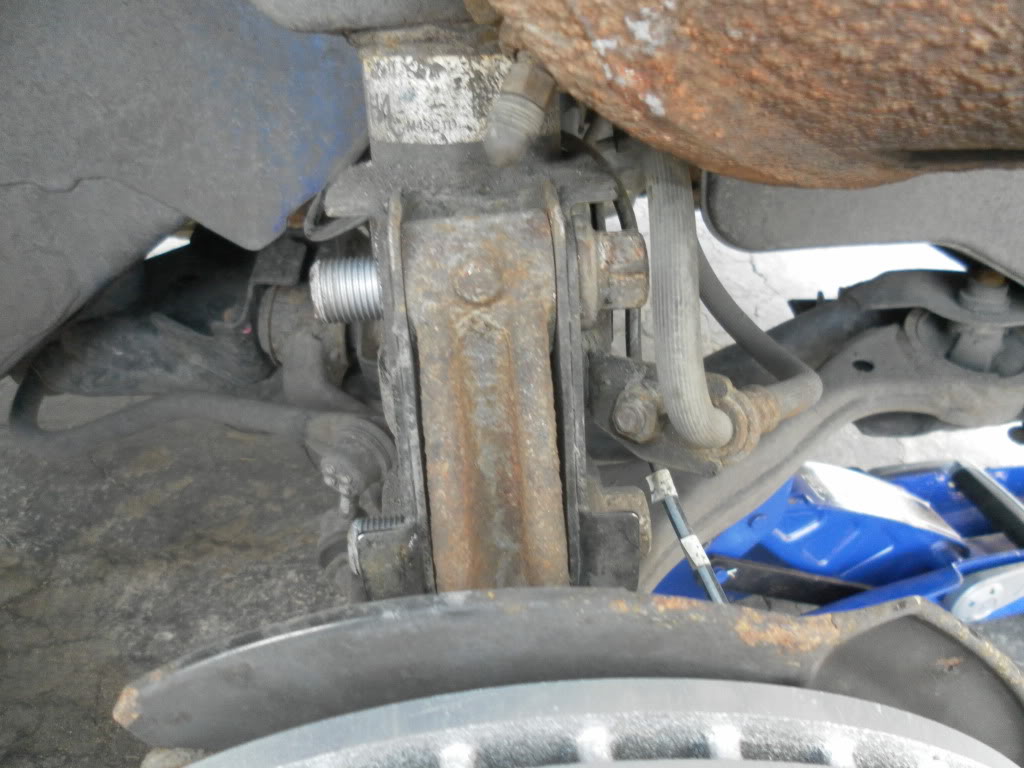
Knuckle/Ball joint/Shaft CV axle/ABS sensor/LCA

LCA and strut knuckle removed
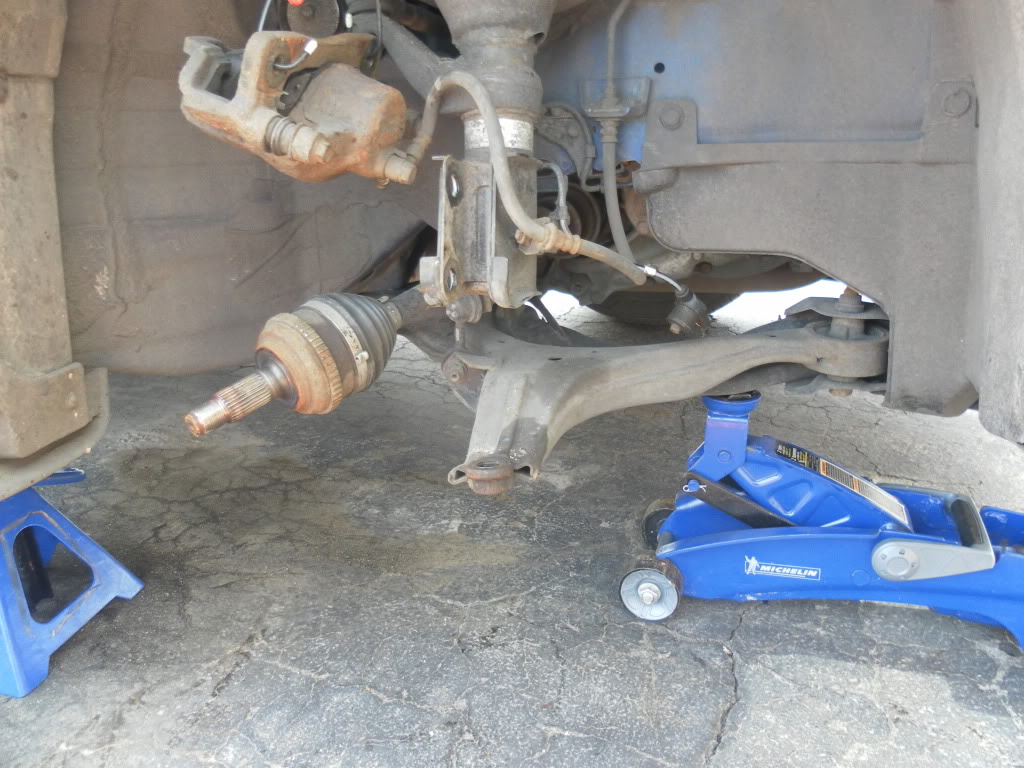
Thanks and RIP, IML.
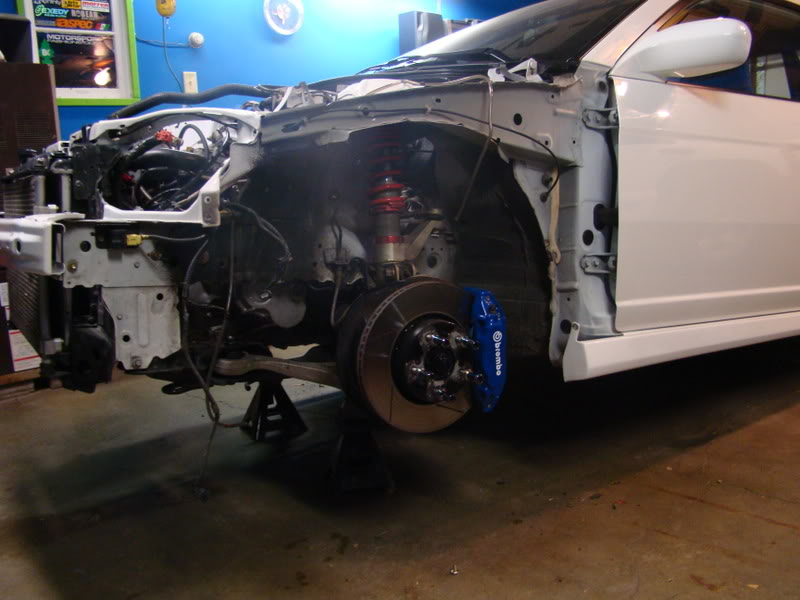
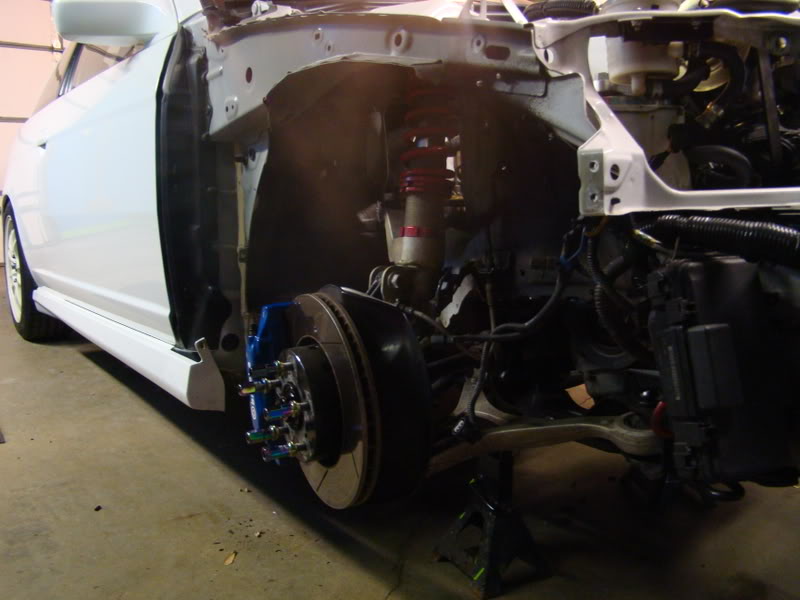
Struts out
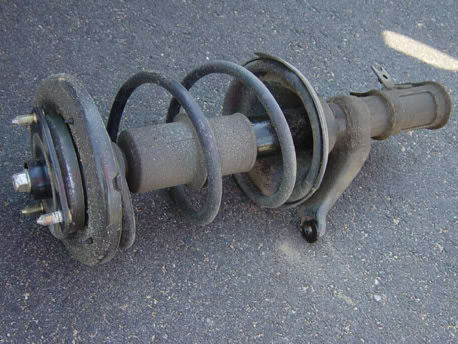
Overall view again
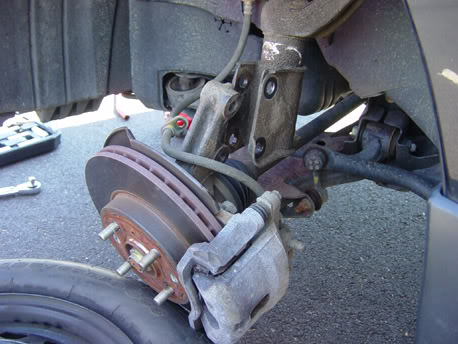
Rear: (Thanks, Robbclark1)
Upper arm and the strut
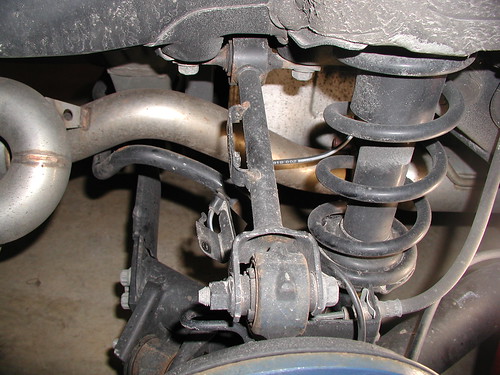
Trailing arm (hub/knuckle, toelinks removed)
Note that the trailing arm now does not hold directly the hub/drums. 7th gen had a kind of knuckle added to the suspension.

8th gen - yeah, i was surprised when i saw it too, the springs are separated from the struts...
The more i see pics and read about them, the more i am convinced that the 7th gen suspension was just an intermediary transition to a good strut type suspension...
The 8th gen is truly an evolution in terms of suspension compared to the simpler 7th gen... ...
Fronts:
The towers are almost under the windshield - expect better stiffness from the strut

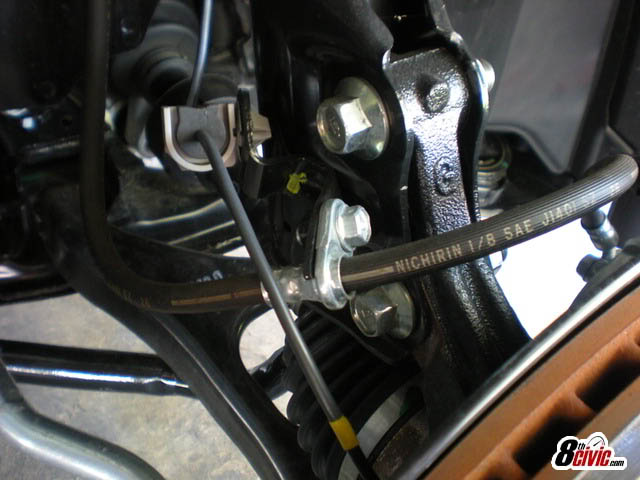
Ball Joint - removable from the LCA instead of integrated to the knuckle - much easier to replace...
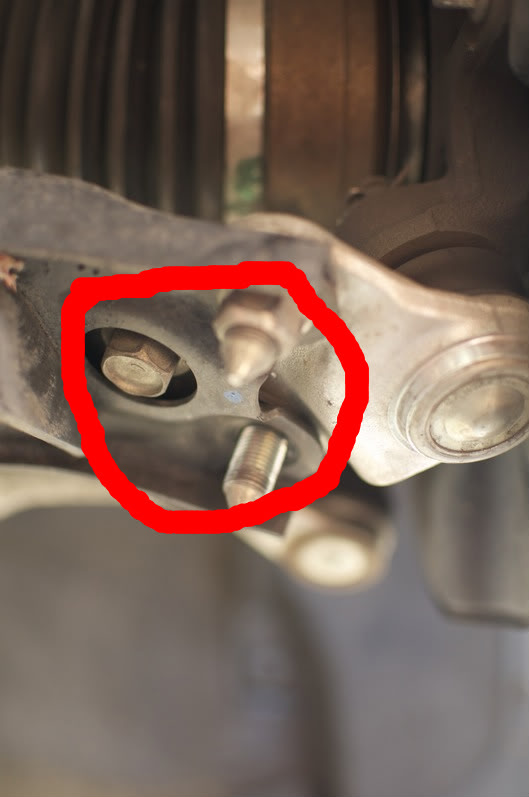
Where in the hell did they put the front sway?!?
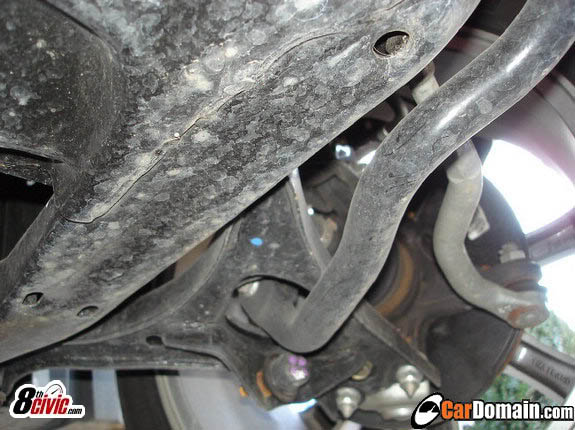
the bolt linking the sway to the arm. Kind of hard to remove, though...
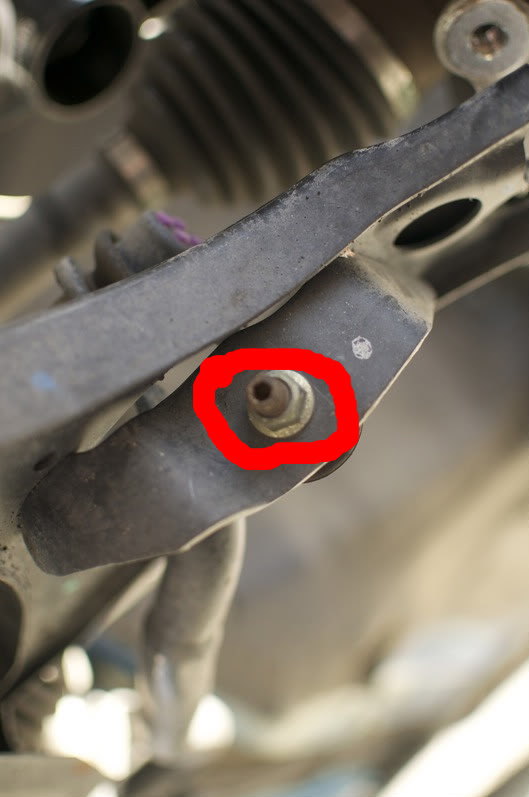
Another view, with BJ removed
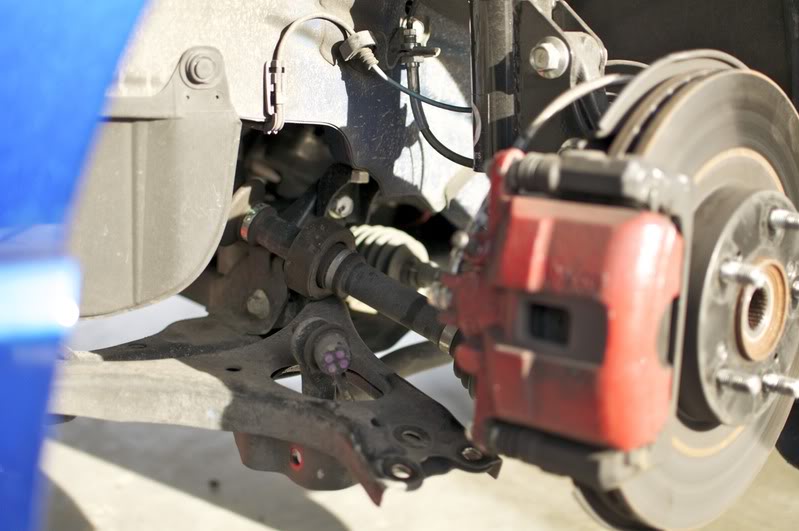
Rears

Note how now angle and mounting point of the upper arm is different, chassis mounting point is lower than before.

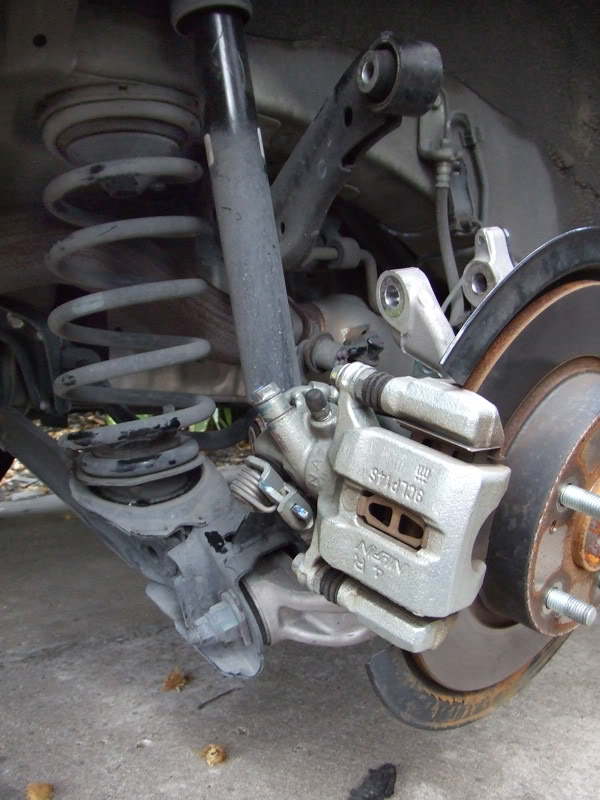
Don't get caught on what the guy is pointing -this is to show the trailing arms and the upper arm.
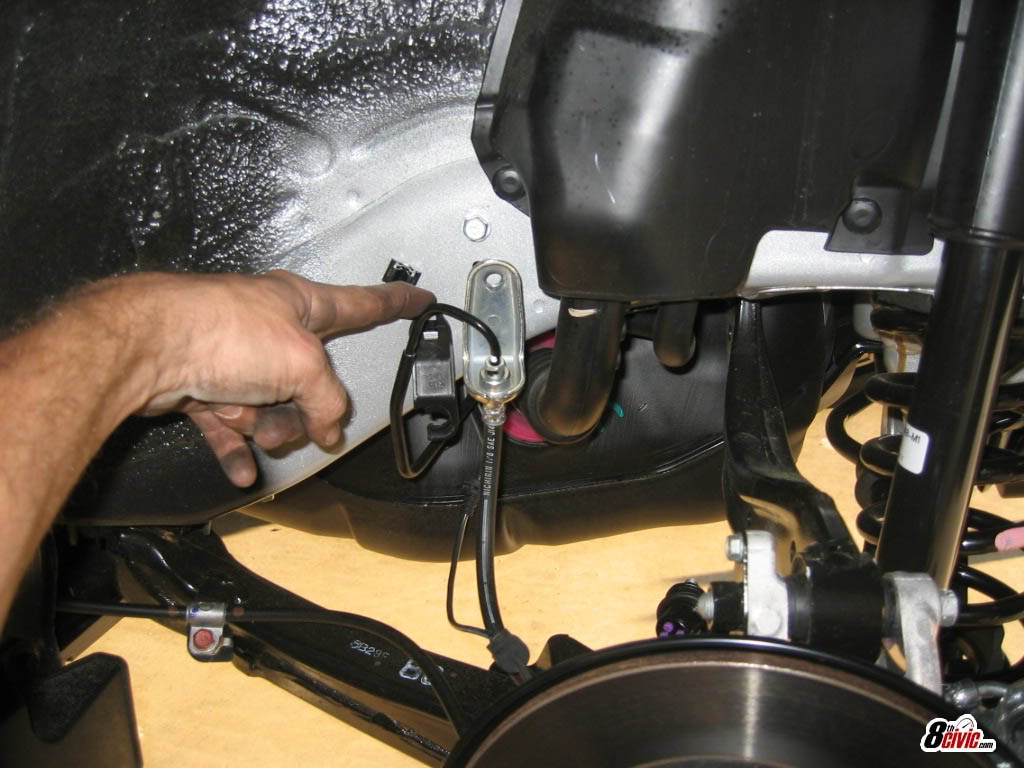
They have the toe adjustment bolt as the 7th gen.
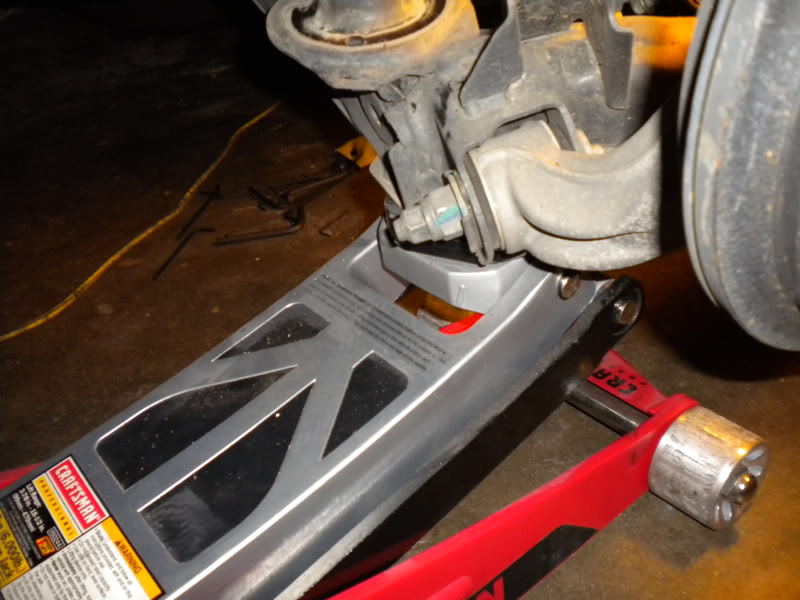
Buuut, they have the camber adjustment bolt as well...
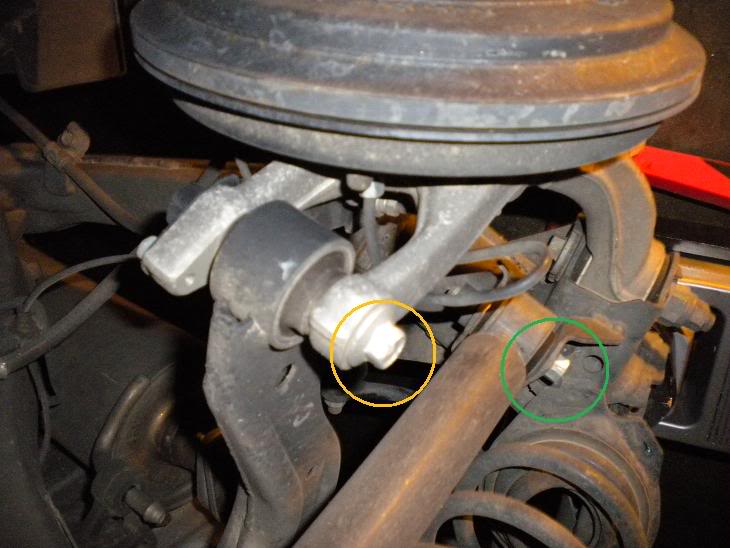
An exploded view of the rears:
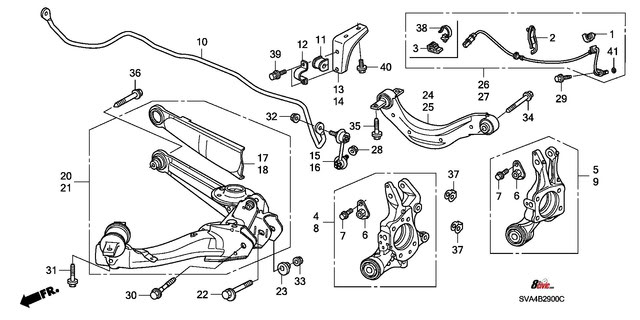
 )
)Front:
Differing from other double wishbone types, the upper arm is considerably high in the car, and mounted in the chassis, not a sub-frame. this is more prone to chassis flex than i initially thought of the suspension...
compare with the most normal type, monted in the sub-frame...


upper control arm
LCA
Rear:
Now note below that there is no "knuckle type - the arm itself holds the hub/drum.
Trailing arm removed
7th gen
Fronts: (Thanks, Tbohar)
A view of the strut with kuckle/disk in place
Strut-to-knuckle "camber" bolts:
Knuckle/Ball joint/Shaft CV axle/ABS sensor/LCA

LCA and strut knuckle removed
Thanks and RIP, IML.
Struts out
Overall view again
Rear: (Thanks, Robbclark1)
Upper arm and the strut

Trailing arm (hub/knuckle, toelinks removed)
Note that the trailing arm now does not hold directly the hub/drums. 7th gen had a kind of knuckle added to the suspension.

8th gen - yeah, i was surprised when i saw it too, the springs are separated from the struts...
The more i see pics and read about them, the more i am convinced that the 7th gen suspension was just an intermediary transition to a good strut type suspension...
The 8th gen is truly an evolution in terms of suspension compared to the simpler 7th gen... ...
Fronts:
The towers are almost under the windshield - expect better stiffness from the strut

Ball Joint - removable from the LCA instead of integrated to the knuckle - much easier to replace...
Where in the hell did they put the front sway?!?
the bolt linking the sway to the arm. Kind of hard to remove, though...
Another view, with BJ removed
Rears

Note how now angle and mounting point of the upper arm is different, chassis mounting point is lower than before.

Don't get caught on what the guy is pointing -this is to show the trailing arms and the upper arm.
They have the toe adjustment bolt as the 7th gen.
Buuut, they have the camber adjustment bolt as well...
An exploded view of the rears:
Last edited by sdaidoji; 05-12-2011 at 06:05 PM.
#5
PITA Admin
Administrator
Thread Starter
iTrader: (1)
Join Date: Dec 2008
Location: TN
Age: 52
Posts: 14,791
Received 1,446 Likes
on
1,201 Posts
Rep Power: 338 










Re: McPherson, double wishbone, torsion bars - what are they?!?
this is from the team integra forums, courtesy of the member Michael Delaney
http://www.team-integra.net/forum/bl...-compared.html
Double Wishbone vs. MacPherson Strut I:The Basics
Posted 12-07-2002 at 12:00 AM by MichaelDelaney
Tags
--------------------------------------------------------------------------------
PREFACE
The following article was written by Bampf many years back in my old Integra Forum Tech Archive Stickies, when I was a mod on another Honda board. It was such a good article that having found it again while purging my hard drive, I thought that it should go back up to educate people here regarding the Gen. 4 Integra's (RSX's) MacPherson strut suspension compared to the Gen. Integras' Double Wishbone suspension. My thanks goes to Bampf once again for investing his own time and effort to assist in making the Integra enthusiasts community become a more informed knowledgeable group.
INTRODUCTION
Tuan asked me to post something on MacPherson Strut type suspensions versus Double Wishbone type suspensions, so here it is (even though it%u2019s a lot later than I had promised it to him %u2013 sorry it took me so long Tuan). This is probably going to be fairly long, but I wanted to make sure that I covered all of the important points (plus I'm long-winded), so please bear with me. Well, let's get to it...
Nearly all cars in production today use either a MacPherson Strut type suspension or Double Wishbone type suspension for the front and rear of the car (the MacPherson Strut is known as a Chapman Strut when used on the rear of the car, but they are identical in every way but name).
Both of these suspension types are independent sus meaning that on whatever end of the car they are installed on, vertical movement of the suspension on the right side of the vehicle does not directly effect the suspension on the left side; basically the two sides of the car are not directly linked to each other so they can move independently of each other. Both of these systems also use a "coil-over-oil" design for the springs and shocks on the car, meaning that the shock absorbers are mounted inside the coils of the springs.
Now let's talk about what each of these are designed like, and then we'll go on to the advantages and disadvantages of each of these
systems.
MACPHERSON STRUTS
I'll start with the MacPherson Strut (Chapman Strut) design. This was invented by Earl S. MacPherson in the 1940's. The MacPherson Strut is basically the simplest of the front independent suspension designs.
Like I mentioned above, this system uses a "coil-over-oil" design. The piston rod of the shock absorber is used to serve as a kingpin axis at the top of the strut. At the bottom, the spring and shock combo pivot on a ball joint on the single lower arm (which is often an A-arm). When turning, the entire strut column (basically the shock body) is twisted in order to turn the wheel, which would cause the spring to "wind-up"(the strut is twisting, but the spring wouldn't, causing the spring to be twisted, or wind-up). In order to solve this problem a thrust bearing is placed at the top of the spring to prevent spring wind-up during turns. Now in a MacPherson Strut type suspension design, the strut itself is the load bearing member, with the springs and shocks merely performing their respective duties instead of also holding up the car.
There is a lot of confusion surrounding this, so I would like to
address that quickly before moving on:
Many people believe that the MacPherson Strut design doesn't use shock absorbers at all, that it uses what they call "a strut" which they think is completely different from a shock absorber. So when they talk about MacPherson Strut type suspensions, they will tell you that MacPherson Strut type designs do not use shock absorbers, that they use struts. I have encountered many other misconceptions about this issue, but that one is by far the most common. Now there isn't anything that you can do to damage your car if you use the term strut instead of shock absorber, but I thought I'd better clear up the terminology problems here. These misconceptions are completely understandable, as there are so many different people in the business using almost as many different terms. (hehehe, I told you I am long-winded)
I'm going to try and explain the difference as best I can. A strut is the load-bearing member of the MacPherson/Chapman Strut suspension design. A shock absorber, or more correctly a damper, is the thing in your suspension that counteracts the movement of the springs in order to stop the car from constantly bouncing up and down over and over after you hit a bump in the road.
Now here's where the confusion comes from: The strut and the shock absorber are integrated together in a strut type suspension. They are two different things, but they come in one package all integrated together. It is not a major problem, but since I'm writing this anyway, I thought I'd clear that up. So even though the strut and shock absorber are integrated into the same housing basically, they are two different things...the strut bears the weight of the car, effectively holding the car up, and the shock absorbers counteract the movement of the springs. So cars with a MacPherson Strut suspension have BOTH struts and shocks.
Ok, back to the MacPherson Strut. So, we've got the wheel of the car attached to the bottom of the strut by a lower A-arm (in almost all cases today), and a near vertical strut. Steering is accomplished by the steering gear being connected either directly to the lower part of the strut, or to an arm from the front or back of the spindle.
Before I move on to Double Wishbone suspensions, a quick side note about the way the MacPherson Strut allows the twisting that takes place when the steering wheel is turned. The spring is seated in a special plate at the top of the strut assembly. When this plate, or the springs get worn, a loud "clunk" is usually heard at full lock (the steering wheel turned as far as it will go in one direction) as the spring frees itself from the proper place on the plate and then snaps back into place. The reason that I mention this is that this noise is often confused with a CV joint knock, so if you're hearing something that you think is a CV joint problem, you may want to have the springs and plate checked as well.
DOUBLE WISHBONE
All right, now onto the Double Wishbone suspension type. Unfortunately, it is very difficult to explain all of the parts of this type of suspension and how it works, so I'm just going to do a quick overview so you understand basically what is going on. With this type of suspension, the upright supporting the wheel is attached to the frame of the car with a pair of links in the shape of a wishbone. These links are connected to the frame by bearings called suspension pivots (which are either metal or rubber, or now-a-days polyurethane). These links (arms) are not always parallel, and are usually of unequal lengths. The Double Wishbone suspension is a type of Double A-arm suspension. Double A-arm suspension systems have been around for about 50 years now. Early versions had equal length arms, but this caused the wheels of the car to lean outboard in turns (increased positive camber). When unequal length arms were developed the positive camber change problem was solved, and in fact was changed to a huge advantage because it made the wheels develop increased negative camber during vertical suspension movement. Double Wishbone suspension also use the "coil-over-oil" design, much like the MacPherson Strut, which often leads to people calling the shock absorbers on their cars "struts" even when their cars don't use a strut type suspension.
I've included pictures of each suspension type to try and make what I'm saying a little clearer. Especially with the Double Wishbone suspension, the pics can probably give you a better idea of how the suspension works than I can with words. Of course, the best way to figure it all out is to get under a car with a Double Wishbone suspension type and look at it to try and figure out how everything works. Don't feel bad if it doesn't make sense though, there are plenty of mechanics out there that don't understand how a Double Wishbone suspension works, it's a very complicated system. Today, engineers use computers to help them design the systems because there are too many variables to deal with to do it by hand without taking an extremely long time.
He also added more:
http://www.team-integra.net/forum/bl...-i-basics.html
Double Wishbone vs. MacPherson Strut II: Compared
Posted 12-07-2002 at 12:00 AM by MichaelDelaney
Tags
--------------------------------------------------------------------------------
PREFACE
This is a continuation or Part 2. of the Double Wishbone vs. MacPherson Strut Suspensions Comparison Series written by my friend Bampf which first appeared in my Tech Archive Stickies when I was a Moderator on another Honda board. The Basics are posted in the Articles FAQ/Info section:
http://www.team-integra.net/sections...?ArticleID=525
Once again, my gratitude goes to Bampf for his efforts.
ADVANTAGES AND DISADVANTAGES
All right, I guess that I'll go into the advantages and disadvantages of each type now.
MACPHERSON STRUT
The MacPherson Strut is the simpler of the two suspension designs, and as such, there are fewer things that can go wrong with a strut type suspension. Also, the MacPherson Strut takes up a little less room horizontally, which allows for more room for the front drive axle to pass through the front , and it allows for more passenger compartment space. MacPherson Struts are also relatively inexpensive compared to any of the other independent suspension types. Another big advantage to a MacPherson Strut design is reduced unsprung weight, which not only reduces the total weight of the car, but unsprung weight has a bigger effect on acceleration than weight inside the car. For example, if you reduced unsprung weight by 20 lbs, you would have to remove nearly 10 times as much weight from the passenger compartment (I'm not sure about the "10 times" part, I haven't heard any exact number, but it is fairly correct, and I put it in here only to impress upon you how important unsprung weight can be). Also, this reduction of unsprung weight increases the ride comfort exhibited by the car. With no upper arm (and sometimes no lower arm) engineers are able to directly control the vibration of the car with no need for the vibration to travel through initial members. This results in better ride comfort than most other
systems have.
There are some disadvantages to this system as well. First, it's a very tall assembly, making this system impractical on race cars, and means that you won't be able to lower a car with MacPherson Struts as much as other systems. MacPherson Struts also have a problem with the amount of room available for wider wheels, without increasing the scrub radius. The scrub radius is the distance from the ball joint line to the centerline of that wheel. Basically you want to minimize the scrub radius because any bump or cornering force that is applied to the tire can exert a twisting force on the steering that is proportional to the length of the scrub radius. So if you were able to get the scrub radius to be zero, the car wouldn't really need power steering (the twisting forces due to the length of the scrub radius would be gone, so the tire would easily rotate about the steering axis). This means that getting wider wheels will increase the scrub radius, and you will need to use more effort to steer the car. Another disadvantage of MacPherson Strut suspensions is that there is very little camber change with vertical suspension movement. This means that the tires on the outside of the turn are going to have positive camber as the body rolls. This means that the contact patch of the outside tires is reduced as the body rolls during a turn. Since the outside tires are the ones that are providing the most cornering force, you want them to have as large a contact patch as possible.
Despite the disadvantages of the MacPherson Strut suspension design, many cars use this suspension (probably mainly due to the ride quality, and because it is so inexpensive).
Now, there aren't very many disadvantages to a Double Wishbone
suspension. One of the biggest is the cost, because these systems are
so complicated and difficult to design and because of all the different parts involved. However, many companies believe that the handling gains are worth the extra expense. Another disadvantage would be that with so many different parts, there is more that can go wrong or break, and again because of the complexity of the system, repairs are usually more expensive. Also, again due to the complexity, modifying the suspension of the car properly is a little more difficult because it is extremely difficult to predict all of the effects changing one variable would have.
DOUBLE WISHBONE
There are quite a few advantages to the Double Wishbone suspension design. First of all, because of the length of the upper and lower arms, vertical suspension movement results in an increase in negative camber. This means that the tires on the outside of a turn stay in better contact with the road, because the negative camber gain that occurs as the body roll helps make sure that the contact patch of the tire is as large as possible. Also, this allows the car to keep a larger contact patch (the exact length of the upper and lower arms determine how much camber gain there is) during all conditions (except for the tires on the inside of a turn, but since they don't provide as much cornering force as the outside tires, this trade-off still ends up with an overall gain in handling performance). Because the camber changes when there is vertical suspension movement, it is possible to have the proper negative camber during a turn without having that same amount of camber when the car is going in a straight line, whereas, with other systems you would have to dial in a certain amount of negative camber that would always be there even when the car is going straight which would lead to increased tire wear. Also, the rigidity of the system prevents deflections during hard cornering, which keeps the steering and wheel alignment constant, even under a lot of stress.
Also, because the length of the arms can be specifically designed for the car, and because those arms can be mounted at various angles to the ground, the engineers can use computers to design the suspension for certain amounts of camber gain, a certain amount dive resistance during braking, and can design the suspension for just about any roll center height and swing-arm length. With so many options open to the engineer, and with the computer programs available today, chassis engineers can tune the suspension to perform as well as possible in all conditions (though for production cars they end up leaning towards safety and ride comfort instead of the best handling possible).
CONCLUSIONS
Please don't come away from this believing that MacPherson Struts are the worst things on the planet, they aren't, they just aren't as flexible as a Double Wishbone suspension is. Also, don't allow yourself to believe that just because you have a Double Wishbone suspension your car automatically handles better than cars with MacPherson Struts.
Plenty of the best handling production cars have used MacPherson Struts. All that having MacPherson Struts means is that you will have to spend a little more time planning your suspension upgrades if you want the best possible handling from your car (and you will end up sacrificing a few more things than you would with a Double Wishbone suspension, like tires - you can dial in the amount of negative camber you want in a MacPherson Strut, but you will end up using tires faster). Because of the simplicity of the MacPherson Strut design, it is sometimes easier to modify the suspension to fit your exact needs than it is with a Double Wishbone suspension. Also, with MacPherson Struts you will need to be more aware of your driving techniques (which to me is actually an asset for someone just starting to race, and even for some experienced drivers, but that all depends on your point of view).
For the average driver (even the slightly more performance- oriented drivers) will not notice very much of a difference between a MacPherson Strut versus a Double Wishbone, because they probably aren't using more than 60% of either system's capabilities anyway. When modifying, the Double Wishbone suspension's advantages can become it's disadvantages, because the complexity of the system makes it more difficult to predict what making one change will end up doing to your handling characteristics. But, on the other hand, if you know what you are doing, a Double Wishbone suspension can be more perfectly tuned to match the particular driver.
ADDENDUM
Note, in the second part of this I stated that:
Quote:
unsprung weight has a bigger effect on acceleration than weight
inside the car.
This isn't quite correct. It is the rotational mass that increases
acceleration, and in the suspension all of the rotational mass that you would be talking about for acceleration also happens to be unsprung weight.
However, the struts would have no effect on acceleration other
than the weight reduction. What I meant to say there is: reducing the
unsprung weight (like with MacPherson Struts) has a big effect on ride
comfort, and it greatly reduces the work the suspension has to do, which ends up in some parts lasting longer and staying in peak condition longer.
Also, I noticed that my use of the word "flexible" when I said:
Quote:
Please don't come away from this believing that MacPherson Struts
are the worst things on the planet, they aren't, they just aren't as
flexible as a Double Wishbone suspension is.
I think it would be easier to understand what I meant if you replace the word "flexible" with "versatile".
http://www.team-integra.net/forum/bl...-compared.html
Double Wishbone vs. MacPherson Strut I:The Basics
Posted 12-07-2002 at 12:00 AM by MichaelDelaney
Tags
--------------------------------------------------------------------------------
PREFACE
The following article was written by Bampf many years back in my old Integra Forum Tech Archive Stickies, when I was a mod on another Honda board. It was such a good article that having found it again while purging my hard drive, I thought that it should go back up to educate people here regarding the Gen. 4 Integra's (RSX's) MacPherson strut suspension compared to the Gen. Integras' Double Wishbone suspension. My thanks goes to Bampf once again for investing his own time and effort to assist in making the Integra enthusiasts community become a more informed knowledgeable group.
INTRODUCTION
Tuan asked me to post something on MacPherson Strut type suspensions versus Double Wishbone type suspensions, so here it is (even though it%u2019s a lot later than I had promised it to him %u2013 sorry it took me so long Tuan). This is probably going to be fairly long, but I wanted to make sure that I covered all of the important points (plus I'm long-winded), so please bear with me. Well, let's get to it...
Nearly all cars in production today use either a MacPherson Strut type suspension or Double Wishbone type suspension for the front and rear of the car (the MacPherson Strut is known as a Chapman Strut when used on the rear of the car, but they are identical in every way but name).
Both of these suspension types are independent sus meaning that on whatever end of the car they are installed on, vertical movement of the suspension on the right side of the vehicle does not directly effect the suspension on the left side; basically the two sides of the car are not directly linked to each other so they can move independently of each other. Both of these systems also use a "coil-over-oil" design for the springs and shocks on the car, meaning that the shock absorbers are mounted inside the coils of the springs.
Now let's talk about what each of these are designed like, and then we'll go on to the advantages and disadvantages of each of these
systems.
MACPHERSON STRUTS
I'll start with the MacPherson Strut (Chapman Strut) design. This was invented by Earl S. MacPherson in the 1940's. The MacPherson Strut is basically the simplest of the front independent suspension designs.
Like I mentioned above, this system uses a "coil-over-oil" design. The piston rod of the shock absorber is used to serve as a kingpin axis at the top of the strut. At the bottom, the spring and shock combo pivot on a ball joint on the single lower arm (which is often an A-arm). When turning, the entire strut column (basically the shock body) is twisted in order to turn the wheel, which would cause the spring to "wind-up"(the strut is twisting, but the spring wouldn't, causing the spring to be twisted, or wind-up). In order to solve this problem a thrust bearing is placed at the top of the spring to prevent spring wind-up during turns. Now in a MacPherson Strut type suspension design, the strut itself is the load bearing member, with the springs and shocks merely performing their respective duties instead of also holding up the car.
There is a lot of confusion surrounding this, so I would like to
address that quickly before moving on:
Many people believe that the MacPherson Strut design doesn't use shock absorbers at all, that it uses what they call "a strut" which they think is completely different from a shock absorber. So when they talk about MacPherson Strut type suspensions, they will tell you that MacPherson Strut type designs do not use shock absorbers, that they use struts. I have encountered many other misconceptions about this issue, but that one is by far the most common. Now there isn't anything that you can do to damage your car if you use the term strut instead of shock absorber, but I thought I'd better clear up the terminology problems here. These misconceptions are completely understandable, as there are so many different people in the business using almost as many different terms. (hehehe, I told you I am long-winded)
I'm going to try and explain the difference as best I can. A strut is the load-bearing member of the MacPherson/Chapman Strut suspension design. A shock absorber, or more correctly a damper, is the thing in your suspension that counteracts the movement of the springs in order to stop the car from constantly bouncing up and down over and over after you hit a bump in the road.
Now here's where the confusion comes from: The strut and the shock absorber are integrated together in a strut type suspension. They are two different things, but they come in one package all integrated together. It is not a major problem, but since I'm writing this anyway, I thought I'd clear that up. So even though the strut and shock absorber are integrated into the same housing basically, they are two different things...the strut bears the weight of the car, effectively holding the car up, and the shock absorbers counteract the movement of the springs. So cars with a MacPherson Strut suspension have BOTH struts and shocks.
Ok, back to the MacPherson Strut. So, we've got the wheel of the car attached to the bottom of the strut by a lower A-arm (in almost all cases today), and a near vertical strut. Steering is accomplished by the steering gear being connected either directly to the lower part of the strut, or to an arm from the front or back of the spindle.
Before I move on to Double Wishbone suspensions, a quick side note about the way the MacPherson Strut allows the twisting that takes place when the steering wheel is turned. The spring is seated in a special plate at the top of the strut assembly. When this plate, or the springs get worn, a loud "clunk" is usually heard at full lock (the steering wheel turned as far as it will go in one direction) as the spring frees itself from the proper place on the plate and then snaps back into place. The reason that I mention this is that this noise is often confused with a CV joint knock, so if you're hearing something that you think is a CV joint problem, you may want to have the springs and plate checked as well.
DOUBLE WISHBONE
All right, now onto the Double Wishbone suspension type. Unfortunately, it is very difficult to explain all of the parts of this type of suspension and how it works, so I'm just going to do a quick overview so you understand basically what is going on. With this type of suspension, the upright supporting the wheel is attached to the frame of the car with a pair of links in the shape of a wishbone. These links are connected to the frame by bearings called suspension pivots (which are either metal or rubber, or now-a-days polyurethane). These links (arms) are not always parallel, and are usually of unequal lengths. The Double Wishbone suspension is a type of Double A-arm suspension. Double A-arm suspension systems have been around for about 50 years now. Early versions had equal length arms, but this caused the wheels of the car to lean outboard in turns (increased positive camber). When unequal length arms were developed the positive camber change problem was solved, and in fact was changed to a huge advantage because it made the wheels develop increased negative camber during vertical suspension movement. Double Wishbone suspension also use the "coil-over-oil" design, much like the MacPherson Strut, which often leads to people calling the shock absorbers on their cars "struts" even when their cars don't use a strut type suspension.
I've included pictures of each suspension type to try and make what I'm saying a little clearer. Especially with the Double Wishbone suspension, the pics can probably give you a better idea of how the suspension works than I can with words. Of course, the best way to figure it all out is to get under a car with a Double Wishbone suspension type and look at it to try and figure out how everything works. Don't feel bad if it doesn't make sense though, there are plenty of mechanics out there that don't understand how a Double Wishbone suspension works, it's a very complicated system. Today, engineers use computers to help them design the systems because there are too many variables to deal with to do it by hand without taking an extremely long time.
He also added more:
http://www.team-integra.net/forum/bl...-i-basics.html
Double Wishbone vs. MacPherson Strut II: Compared
Posted 12-07-2002 at 12:00 AM by MichaelDelaney
Tags
--------------------------------------------------------------------------------
PREFACE
This is a continuation or Part 2. of the Double Wishbone vs. MacPherson Strut Suspensions Comparison Series written by my friend Bampf which first appeared in my Tech Archive Stickies when I was a Moderator on another Honda board. The Basics are posted in the Articles FAQ/Info section:
http://www.team-integra.net/sections...?ArticleID=525
Once again, my gratitude goes to Bampf for his efforts.
ADVANTAGES AND DISADVANTAGES
All right, I guess that I'll go into the advantages and disadvantages of each type now.
MACPHERSON STRUT
The MacPherson Strut is the simpler of the two suspension designs, and as such, there are fewer things that can go wrong with a strut type suspension. Also, the MacPherson Strut takes up a little less room horizontally, which allows for more room for the front drive axle to pass through the front , and it allows for more passenger compartment space. MacPherson Struts are also relatively inexpensive compared to any of the other independent suspension types. Another big advantage to a MacPherson Strut design is reduced unsprung weight, which not only reduces the total weight of the car, but unsprung weight has a bigger effect on acceleration than weight inside the car. For example, if you reduced unsprung weight by 20 lbs, you would have to remove nearly 10 times as much weight from the passenger compartment (I'm not sure about the "10 times" part, I haven't heard any exact number, but it is fairly correct, and I put it in here only to impress upon you how important unsprung weight can be). Also, this reduction of unsprung weight increases the ride comfort exhibited by the car. With no upper arm (and sometimes no lower arm) engineers are able to directly control the vibration of the car with no need for the vibration to travel through initial members. This results in better ride comfort than most other
systems have.
There are some disadvantages to this system as well. First, it's a very tall assembly, making this system impractical on race cars, and means that you won't be able to lower a car with MacPherson Struts as much as other systems. MacPherson Struts also have a problem with the amount of room available for wider wheels, without increasing the scrub radius. The scrub radius is the distance from the ball joint line to the centerline of that wheel. Basically you want to minimize the scrub radius because any bump or cornering force that is applied to the tire can exert a twisting force on the steering that is proportional to the length of the scrub radius. So if you were able to get the scrub radius to be zero, the car wouldn't really need power steering (the twisting forces due to the length of the scrub radius would be gone, so the tire would easily rotate about the steering axis). This means that getting wider wheels will increase the scrub radius, and you will need to use more effort to steer the car. Another disadvantage of MacPherson Strut suspensions is that there is very little camber change with vertical suspension movement. This means that the tires on the outside of the turn are going to have positive camber as the body rolls. This means that the contact patch of the outside tires is reduced as the body rolls during a turn. Since the outside tires are the ones that are providing the most cornering force, you want them to have as large a contact patch as possible.
Despite the disadvantages of the MacPherson Strut suspension design, many cars use this suspension (probably mainly due to the ride quality, and because it is so inexpensive).
Now, there aren't very many disadvantages to a Double Wishbone
suspension. One of the biggest is the cost, because these systems are
so complicated and difficult to design and because of all the different parts involved. However, many companies believe that the handling gains are worth the extra expense. Another disadvantage would be that with so many different parts, there is more that can go wrong or break, and again because of the complexity of the system, repairs are usually more expensive. Also, again due to the complexity, modifying the suspension of the car properly is a little more difficult because it is extremely difficult to predict all of the effects changing one variable would have.
DOUBLE WISHBONE
There are quite a few advantages to the Double Wishbone suspension design. First of all, because of the length of the upper and lower arms, vertical suspension movement results in an increase in negative camber. This means that the tires on the outside of a turn stay in better contact with the road, because the negative camber gain that occurs as the body roll helps make sure that the contact patch of the tire is as large as possible. Also, this allows the car to keep a larger contact patch (the exact length of the upper and lower arms determine how much camber gain there is) during all conditions (except for the tires on the inside of a turn, but since they don't provide as much cornering force as the outside tires, this trade-off still ends up with an overall gain in handling performance). Because the camber changes when there is vertical suspension movement, it is possible to have the proper negative camber during a turn without having that same amount of camber when the car is going in a straight line, whereas, with other systems you would have to dial in a certain amount of negative camber that would always be there even when the car is going straight which would lead to increased tire wear. Also, the rigidity of the system prevents deflections during hard cornering, which keeps the steering and wheel alignment constant, even under a lot of stress.
Also, because the length of the arms can be specifically designed for the car, and because those arms can be mounted at various angles to the ground, the engineers can use computers to design the suspension for certain amounts of camber gain, a certain amount dive resistance during braking, and can design the suspension for just about any roll center height and swing-arm length. With so many options open to the engineer, and with the computer programs available today, chassis engineers can tune the suspension to perform as well as possible in all conditions (though for production cars they end up leaning towards safety and ride comfort instead of the best handling possible).
CONCLUSIONS
Please don't come away from this believing that MacPherson Struts are the worst things on the planet, they aren't, they just aren't as flexible as a Double Wishbone suspension is. Also, don't allow yourself to believe that just because you have a Double Wishbone suspension your car automatically handles better than cars with MacPherson Struts.
Plenty of the best handling production cars have used MacPherson Struts. All that having MacPherson Struts means is that you will have to spend a little more time planning your suspension upgrades if you want the best possible handling from your car (and you will end up sacrificing a few more things than you would with a Double Wishbone suspension, like tires - you can dial in the amount of negative camber you want in a MacPherson Strut, but you will end up using tires faster). Because of the simplicity of the MacPherson Strut design, it is sometimes easier to modify the suspension to fit your exact needs than it is with a Double Wishbone suspension. Also, with MacPherson Struts you will need to be more aware of your driving techniques (which to me is actually an asset for someone just starting to race, and even for some experienced drivers, but that all depends on your point of view).
For the average driver (even the slightly more performance- oriented drivers) will not notice very much of a difference between a MacPherson Strut versus a Double Wishbone, because they probably aren't using more than 60% of either system's capabilities anyway. When modifying, the Double Wishbone suspension's advantages can become it's disadvantages, because the complexity of the system makes it more difficult to predict what making one change will end up doing to your handling characteristics. But, on the other hand, if you know what you are doing, a Double Wishbone suspension can be more perfectly tuned to match the particular driver.
ADDENDUM
Note, in the second part of this I stated that:
Quote:
unsprung weight has a bigger effect on acceleration than weight
inside the car.
This isn't quite correct. It is the rotational mass that increases
acceleration, and in the suspension all of the rotational mass that you would be talking about for acceleration also happens to be unsprung weight.
However, the struts would have no effect on acceleration other
than the weight reduction. What I meant to say there is: reducing the
unsprung weight (like with MacPherson Struts) has a big effect on ride
comfort, and it greatly reduces the work the suspension has to do, which ends up in some parts lasting longer and staying in peak condition longer.
Also, I noticed that my use of the word "flexible" when I said:
Quote:
Please don't come away from this believing that MacPherson Struts
are the worst things on the planet, they aren't, they just aren't as
flexible as a Double Wishbone suspension is.
I think it would be easier to understand what I meant if you replace the word "flexible" with "versatile".
Last edited by sdaidoji; 04-17-2011 at 05:57 PM.
#7
Trance Addict
Re: McPherson, double wishbone, torsion bars - what are they?!?
Dammit dude. Every time you post this stuff, you remind me of how I have to read this massive 1000+ page text book .
.
 .
.
#8
PITA Admin
Administrator
Thread Starter
iTrader: (1)
Join Date: Dec 2008
Location: TN
Age: 52
Posts: 14,791
Received 1,446 Likes
on
1,201 Posts
Rep Power: 338 










Re: McPherson, double wishbone, torsion bars - what are they?!?
Well, actually i was thinking that this is too much text...
To hook up a new member, i need to have better diagrams in the first post, then all the text comes later, and i should be clipping off unrelated data, but keep the original ones in a link for who is interested in reading more, let's see how it will come (basics of how to keep the audience awake during presentations
(basics of how to keep the audience awake during presentations  )
)
To hook up a new member, i need to have better diagrams in the first post, then all the text comes later, and i should be clipping off unrelated data, but keep the original ones in a link for who is interested in reading more, let's see how it will come
 (basics of how to keep the audience awake during presentations
(basics of how to keep the audience awake during presentations  )
)
#10
PITA Admin
Administrator
Thread Starter
iTrader: (1)
Join Date: Dec 2008
Location: TN
Age: 52
Posts: 14,791
Received 1,446 Likes
on
1,201 Posts
Rep Power: 338 










Re: McPherson, double wishbone, torsion bars - what are they?!?
added some more info, reduced others, edited for easier view, and it's still so far from completion... siiigh...
I was also surprised there was so much difference in the rear suspension in the 8th gen.
Pheeew...
There are more that needs to be edited, clipped and stuff, but brain went into the mush-state again...
will take a break of a few days again...
I was also surprised there was so much difference in the rear suspension in the 8th gen.
Pheeew...
There are more that needs to be edited, clipped and stuff, but brain went into the mush-state again...
will take a break of a few days again...
Last edited by sdaidoji; 04-17-2011 at 04:16 PM.
#13
PITA Admin
Administrator
Thread Starter
iTrader: (1)
Join Date: Dec 2008
Location: TN
Age: 52
Posts: 14,791
Received 1,446 Likes
on
1,201 Posts
Rep Power: 338 










Re: McPherson, double wishbone, torsion bars - what are they?!?
Updated the pictures by generation - Now looking at the pics myself... There are considerable difference in the 6-7-8th gen geometries... my god...
#14
Whachya lookin at?
iTrader: (1)
Join Date: May 2009
Location: Canada
Age: 38
Posts: 6,388
Likes: 0
Received 11 Likes
on
7 Posts
Rep Power: 289 










Re: McPherson, double wishbone, torsion bars - what are they?!?
Holy sheeet there is a lot of good information here. I'm glad a few of my pictures made it in there too!! 

#15
PITA Admin
Administrator
Thread Starter
iTrader: (1)
Join Date: Dec 2008
Location: TN
Age: 52
Posts: 14,791
Received 1,446 Likes
on
1,201 Posts
Rep Power: 338 










Re: McPherson, double wishbone, torsion bars - what are they?!?
here is just for the fun - this is a miata driver that posted his suspension working in the track - double wishbone
[autostream]http://autostream.com/ibcivicforums/?page_type=firebirdplayerthumbnail&framepage=1081& transactionid=1319498209-691379559&posted_by=sdaidoji_www.civicforums.com&y outube_video_id=jLoQTzdatl0[/autostream]
[autostream]http://autostream.com/ibcivicforums/?page_type=firebirdplayerthumbnail&framepage=1081& transactionid=1319498209-691379559&posted_by=sdaidoji_www.civicforums.com&y outube_video_id=jLoQTzdatl0[/autostream]
Thread
Thread Starter
Honda Civic Forum
Replies
Last Post
solarpunk70
Mechanical Problems/Vehicle Issues and Fix-it Forum
6
04-12-2016 11:43 AM
Raiool
Fuel, Oil, Cleaners & Other Maintenance
3
10-01-2015 10:42 AM


 Keep it up!!!
Keep it up!!! 



